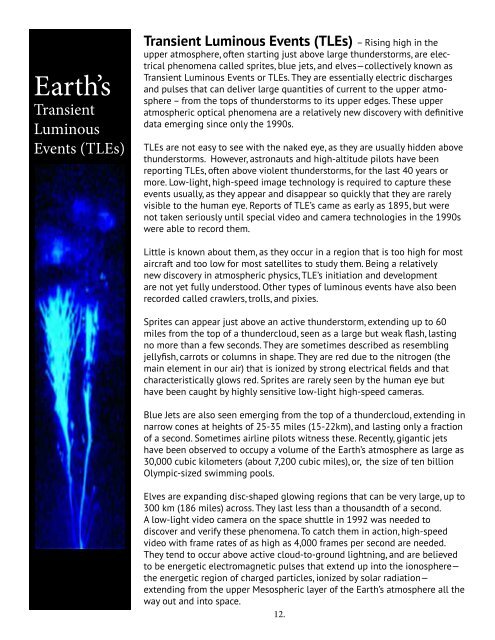Earth's Global Electric Circuit - Spark - University Corporation for ...
Earth's Global Electric Circuit - Spark - University Corporation for ...
Earth's Global Electric Circuit - Spark - University Corporation for ...
You also want an ePaper? Increase the reach of your titles
YUMPU automatically turns print PDFs into web optimized ePapers that Google loves.
Earth’s<br />
Transient<br />
Luminous<br />
Events (TLEs)<br />
Transient Luminous Events (TLEs) – Rising high in the<br />
upper atmosphere, often starting just above large thunderstorms, are electrical<br />
phenomena called sprites, blue jets, and elves—collectively known as<br />
Transient Luminous Events or TLEs. They are essentially electric discharges<br />
and pulses that can deliver large quantities of current to the upper atmosphere<br />
– from the tops of thunderstorms to its upper edges. These upper<br />
atmospheric optical phenomena are a relatively new discovery with definitive<br />
data emerging since only the 1990s.<br />
TLEs are not easy to see with the naked eye, as they are usually hidden above<br />
thunderstorms. However, astronauts and high-altitude pilots have been<br />
reporting TLEs, often above violent thunderstorms, <strong>for</strong> the last 40 years or<br />
more. Low-light, high-speed image technology is required to capture these<br />
events usually, as they appear and disappear so quickly that they are rarely<br />
visible to the human eye. Reports of TLE’s came as early as 1895, but were<br />
not taken seriously until special video and camera technologies in the 1990s<br />
were able to record them.<br />
Little is known about them, as they occur in a region that is too high <strong>for</strong> most<br />
aircraft and too low <strong>for</strong> most satellites to study them. Being a relatively<br />
new discovery in atmospheric physics, TLE’s initiation and development<br />
are not yet fully understood. Other types of luminous events have also been<br />
recorded called crawlers, trolls, and pixies.<br />
Sprites can appear just above an active thunderstorm, extending up to 60<br />
miles from the top of a thundercloud, seen as a large but weak flash, lasting<br />
no more than a few seconds. They are sometimes described as resembling<br />
jellyfish, carrots or columns in shape. They are red due to the nitrogen (the<br />
main element in our air) that is ionized by strong electrical fields and that<br />
characteristically glows red. Sprites are rarely seen by the human eye but<br />
have been caught by highly sensitive low-light high-speed cameras.<br />
Blue Jets are also seen emerging from the top of a thundercloud, extending in<br />
narrow cones at heights of 25-35 miles (15-22km), and lasting only a fraction<br />
of a second. Sometimes airline pilots witness these. Recently, gigantic jets<br />
have been observed to occupy a volume of the Earth’s atmosphere as large as<br />
30,000 cubic kilometers (about 7,200 cubic miles), or, the size of ten billion<br />
Olympic-sized swimming pools.<br />
Elves are expanding disc-shaped glowing regions that can be very large, up to<br />
300 km (186 miles) across. They last less than a thousandth of a second.<br />
A low-light video camera on the space shuttle in 1992 was needed to<br />
discover and verify these phenomena. To catch them in action, high-speed<br />
video with frame rates of as high as 4,000 frames per second are needed.<br />
They tend to occur above active cloud-to-ground lightning, and are believed<br />
to be energetic electromagnetic pulses that extend up into the ionosphere—<br />
the energetic region of charged particles, ionized by solar radiation—<br />
extending from the upper Mesospheric layer of the Earth’s atmosphere all the<br />
way out and into space.<br />
Currently, there is research looking into the possibility of sprites, jets, and<br />
elves playing an important role in the Earth’s <strong>Global</strong> <strong>Electric</strong> <strong>Circuit</strong>. It is<br />
believed that they may help reduce the difference in charges that build up<br />
between the surface and the ionosphere, nearly 50 miles (80 km) or more<br />
above the ground. At this upper level of the Earth’s atmosphere, the<br />
ionization of its gases affects the propagation of radio waves, which can be<br />
essential to global communication.<br />
There are approximately two-thousand thunderstorms at any given<br />
moment raging across the Earth, and they are thought to act as the<br />
generator <strong>for</strong> the <strong>Global</strong> <strong>Electric</strong> <strong>Circuit</strong>. These thunderstorms are thought<br />
to drive electric charges upward into the ionosphere, to then return towards<br />
the Earth’s surface through regions of fair weather.<br />
This happens through the weakly conducting atmosphere in a slow and<br />
continuous discharge. Think of it as if the thunderstorms are acting as the<br />
battery-charging piece or the Earth’ global electric circuit. TLEs help to<br />
offload some of the charge from the ionosphere and appear to emit radio<br />
waves in the process.<br />
TLEs likely play an important role in the Earth’s atmospheric chemistry,<br />
including the <strong>for</strong>mation of ozone and the planet’s chemical cycles. Meteors<br />
also may play a role in some TLEs. Not surprisingly, there is much still to<br />
learn to fully understand Transient Luminous Events and their magnificent<br />
yet fleeting visual displays.<br />
At Right –Blue jets are a high altitude optical phenomenon observed above<br />
thunderstorms using low light television systems. As their name implies, blue<br />
jets are optical ejections from the top of the electrically active core regions of<br />
thunderstorms. They are not aligned with the local magnetic field. Intense<br />
ef<strong>for</strong>ts are presently underway to determine the full extent to which these new<br />
phenomena <strong>for</strong>m a part<br />
of the terrestrial electrical<br />
environment. A clear view<br />
above a thunderstorm is<br />
required. This generally<br />
means the thunderstorm<br />
activity must be on the<br />
horizon. Additionally, there<br />
must be very little intervening<br />
cloud cover. Best<br />
viewing distance from the<br />
storm is 100-200 miles<br />
(200-300 km). One’s<br />
patience can be rewarded.<br />
Source: <strong>University</strong> of Alaska, Fairbanks<br />
12. 13.<br />
Earth’s<br />
Transient<br />
Luminous<br />
Events (TLEs)















